Implementing Supply Chain Recommendations for Unilever - Report
VerifiedAdded on 2023/04/22
|19
|5213
|386
Report
AI Summary
This report discusses the implementation of recommendations made to Unilever regarding its international supply chain strategy. It begins by summarizing the key recommendations, including increasing inventory locations, enhancing supply chain network flexibility, and accommodating RFID technology. The report then delves into the implementation process, focusing on changes in global procurement, such as selecting, buying from, and managing international suppliers. It also addresses improving absorptive capacity, global supply chain network adjustments, and facilitating technology and knowledge transfer. The analysis emphasizes the importance of strategic supplier selection, B2B buying modes, and technology adoption to enhance supply chain efficiency and reduce operational costs for Unilever.
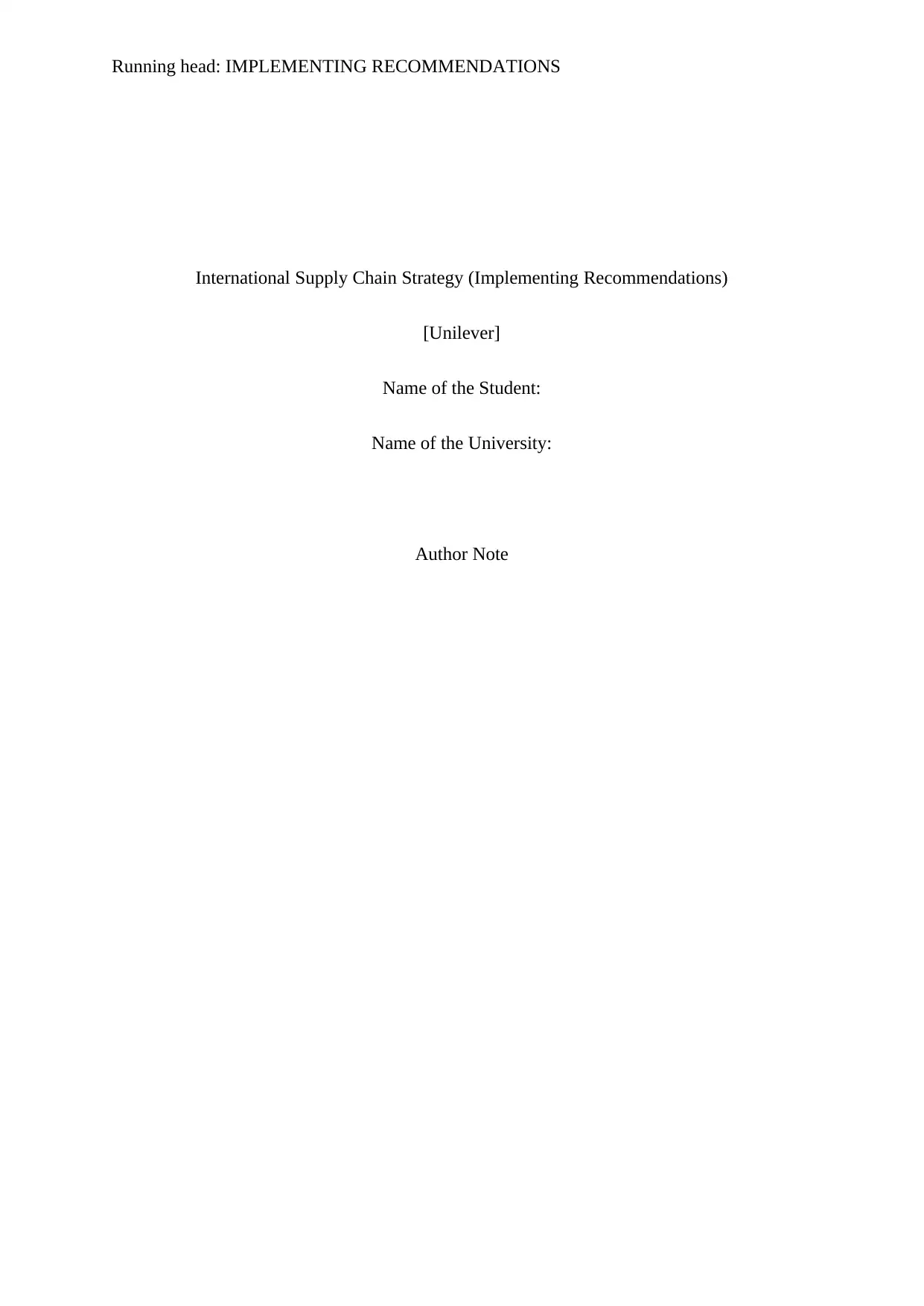
Running head: IMPLEMENTING RECOMMENDATIONS
International Supply Chain Strategy (Implementing Recommendations)
[Unilever]
Name of the Student:
Name of the University:
Author Note
International Supply Chain Strategy (Implementing Recommendations)
[Unilever]
Name of the Student:
Name of the University:
Author Note
Paraphrase This Document
Need a fresh take? Get an instant paraphrase of this document with our AI Paraphraser

1IMPLEMENTING RECOMMENDATIONS
Executive summary
This report is mainly based on discussing the implementation of recommended factors in the
previous assignment. It starts with an introductory section letting the readers know about the
purpose of this report. It proceeds further by summarising the factors of recommendation as
made to Unilever in the first part of this assignment. It then covers the implementation
section by dividing the rest of the discussion in two sections. These are changes in global
procurement and improving absorptive capacity, global supply chain network and facilitating
technology and knowledge transfer.
Executive summary
This report is mainly based on discussing the implementation of recommended factors in the
previous assignment. It starts with an introductory section letting the readers know about the
purpose of this report. It proceeds further by summarising the factors of recommendation as
made to Unilever in the first part of this assignment. It then covers the implementation
section by dividing the rest of the discussion in two sections. These are changes in global
procurement and improving absorptive capacity, global supply chain network and facilitating
technology and knowledge transfer.
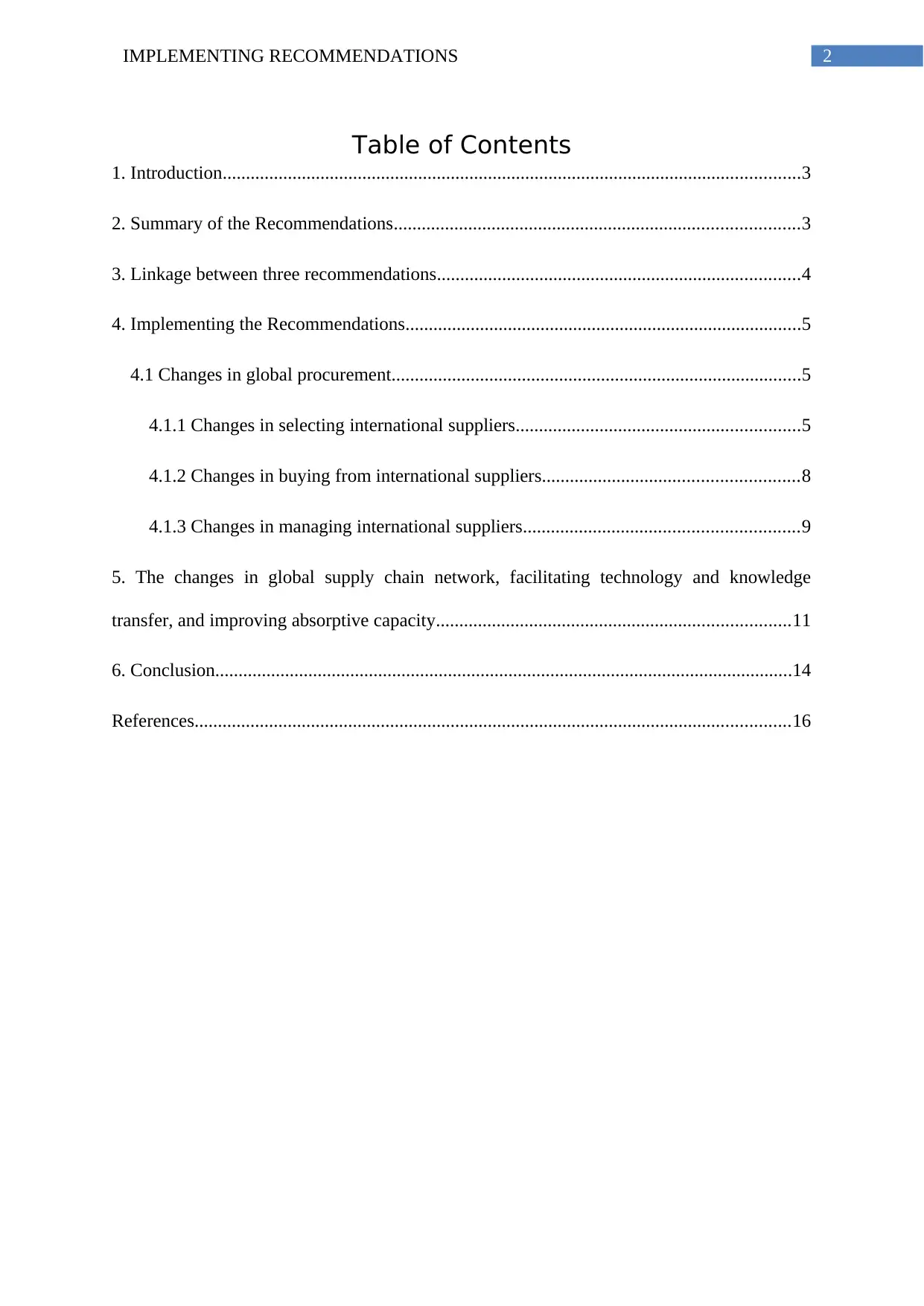
2IMPLEMENTING RECOMMENDATIONS
Table of Contents
1. Introduction............................................................................................................................3
2. Summary of the Recommendations.......................................................................................3
3. Linkage between three recommendations..............................................................................4
4. Implementing the Recommendations.....................................................................................5
4.1 Changes in global procurement........................................................................................5
4.1.1 Changes in selecting international suppliers.............................................................5
4.1.2 Changes in buying from international suppliers.......................................................8
4.1.3 Changes in managing international suppliers...........................................................9
5. The changes in global supply chain network, facilitating technology and knowledge
transfer, and improving absorptive capacity............................................................................11
6. Conclusion............................................................................................................................14
References................................................................................................................................16
Table of Contents
1. Introduction............................................................................................................................3
2. Summary of the Recommendations.......................................................................................3
3. Linkage between three recommendations..............................................................................4
4. Implementing the Recommendations.....................................................................................5
4.1 Changes in global procurement........................................................................................5
4.1.1 Changes in selecting international suppliers.............................................................5
4.1.2 Changes in buying from international suppliers.......................................................8
4.1.3 Changes in managing international suppliers...........................................................9
5. The changes in global supply chain network, facilitating technology and knowledge
transfer, and improving absorptive capacity............................................................................11
6. Conclusion............................................................................................................................14
References................................................................................................................................16
⊘ This is a preview!⊘
Do you want full access?
Subscribe today to unlock all pages.

Trusted by 1+ million students worldwide
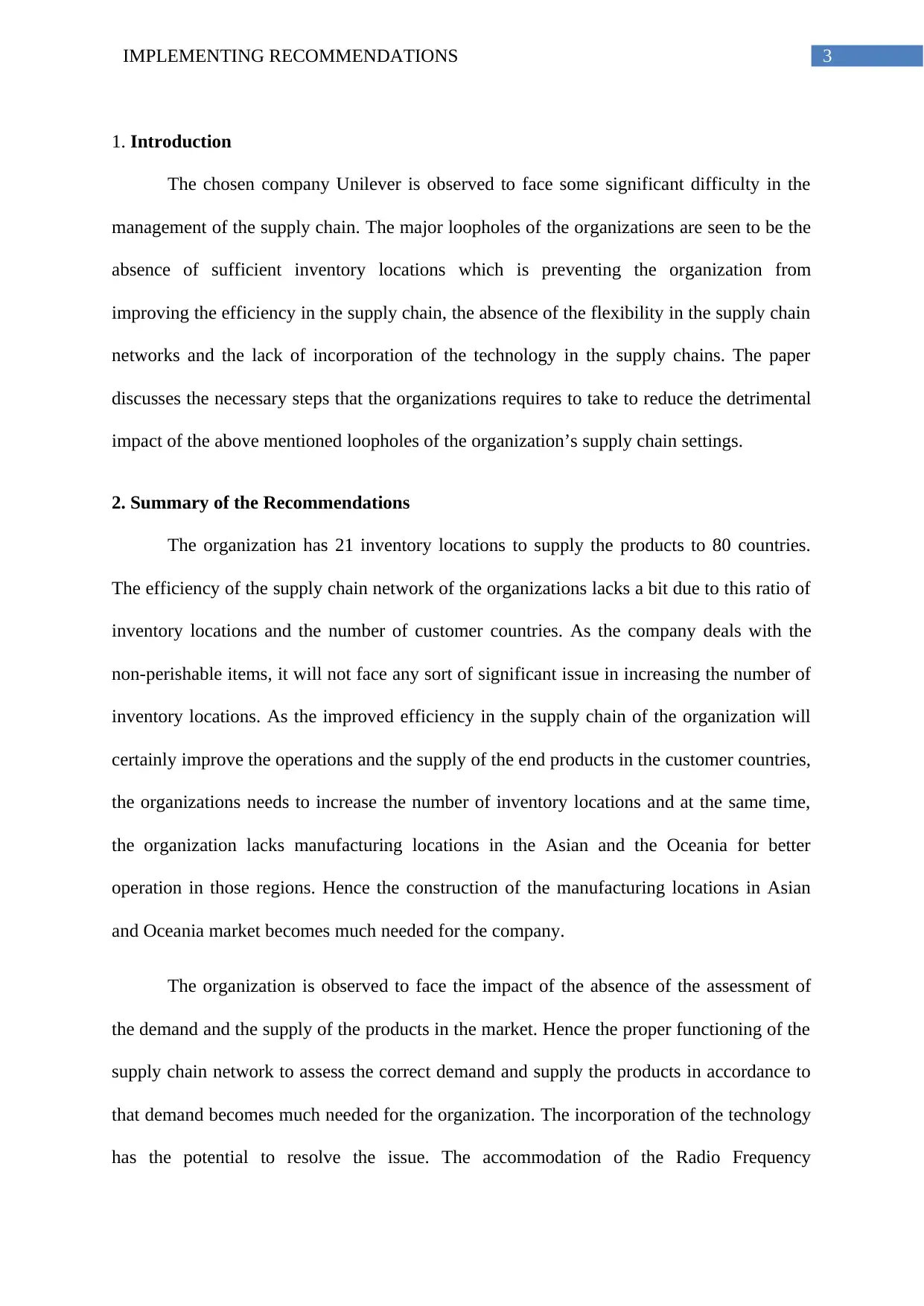
3IMPLEMENTING RECOMMENDATIONS
1. Introduction
The chosen company Unilever is observed to face some significant difficulty in the
management of the supply chain. The major loopholes of the organizations are seen to be the
absence of sufficient inventory locations which is preventing the organization from
improving the efficiency in the supply chain, the absence of the flexibility in the supply chain
networks and the lack of incorporation of the technology in the supply chains. The paper
discusses the necessary steps that the organizations requires to take to reduce the detrimental
impact of the above mentioned loopholes of the organization’s supply chain settings.
2. Summary of the Recommendations
The organization has 21 inventory locations to supply the products to 80 countries.
The efficiency of the supply chain network of the organizations lacks a bit due to this ratio of
inventory locations and the number of customer countries. As the company deals with the
non-perishable items, it will not face any sort of significant issue in increasing the number of
inventory locations. As the improved efficiency in the supply chain of the organization will
certainly improve the operations and the supply of the end products in the customer countries,
the organizations needs to increase the number of inventory locations and at the same time,
the organization lacks manufacturing locations in the Asian and the Oceania for better
operation in those regions. Hence the construction of the manufacturing locations in Asian
and Oceania market becomes much needed for the company.
The organization is observed to face the impact of the absence of the assessment of
the demand and the supply of the products in the market. Hence the proper functioning of the
supply chain network to assess the correct demand and supply the products in accordance to
that demand becomes much needed for the organization. The incorporation of the technology
has the potential to resolve the issue. The accommodation of the Radio Frequency
1. Introduction
The chosen company Unilever is observed to face some significant difficulty in the
management of the supply chain. The major loopholes of the organizations are seen to be the
absence of sufficient inventory locations which is preventing the organization from
improving the efficiency in the supply chain, the absence of the flexibility in the supply chain
networks and the lack of incorporation of the technology in the supply chains. The paper
discusses the necessary steps that the organizations requires to take to reduce the detrimental
impact of the above mentioned loopholes of the organization’s supply chain settings.
2. Summary of the Recommendations
The organization has 21 inventory locations to supply the products to 80 countries.
The efficiency of the supply chain network of the organizations lacks a bit due to this ratio of
inventory locations and the number of customer countries. As the company deals with the
non-perishable items, it will not face any sort of significant issue in increasing the number of
inventory locations. As the improved efficiency in the supply chain of the organization will
certainly improve the operations and the supply of the end products in the customer countries,
the organizations needs to increase the number of inventory locations and at the same time,
the organization lacks manufacturing locations in the Asian and the Oceania for better
operation in those regions. Hence the construction of the manufacturing locations in Asian
and Oceania market becomes much needed for the company.
The organization is observed to face the impact of the absence of the assessment of
the demand and the supply of the products in the market. Hence the proper functioning of the
supply chain network to assess the correct demand and supply the products in accordance to
that demand becomes much needed for the organization. The incorporation of the technology
has the potential to resolve the issue. The accommodation of the Radio Frequency
Paraphrase This Document
Need a fresh take? Get an instant paraphrase of this document with our AI Paraphraser
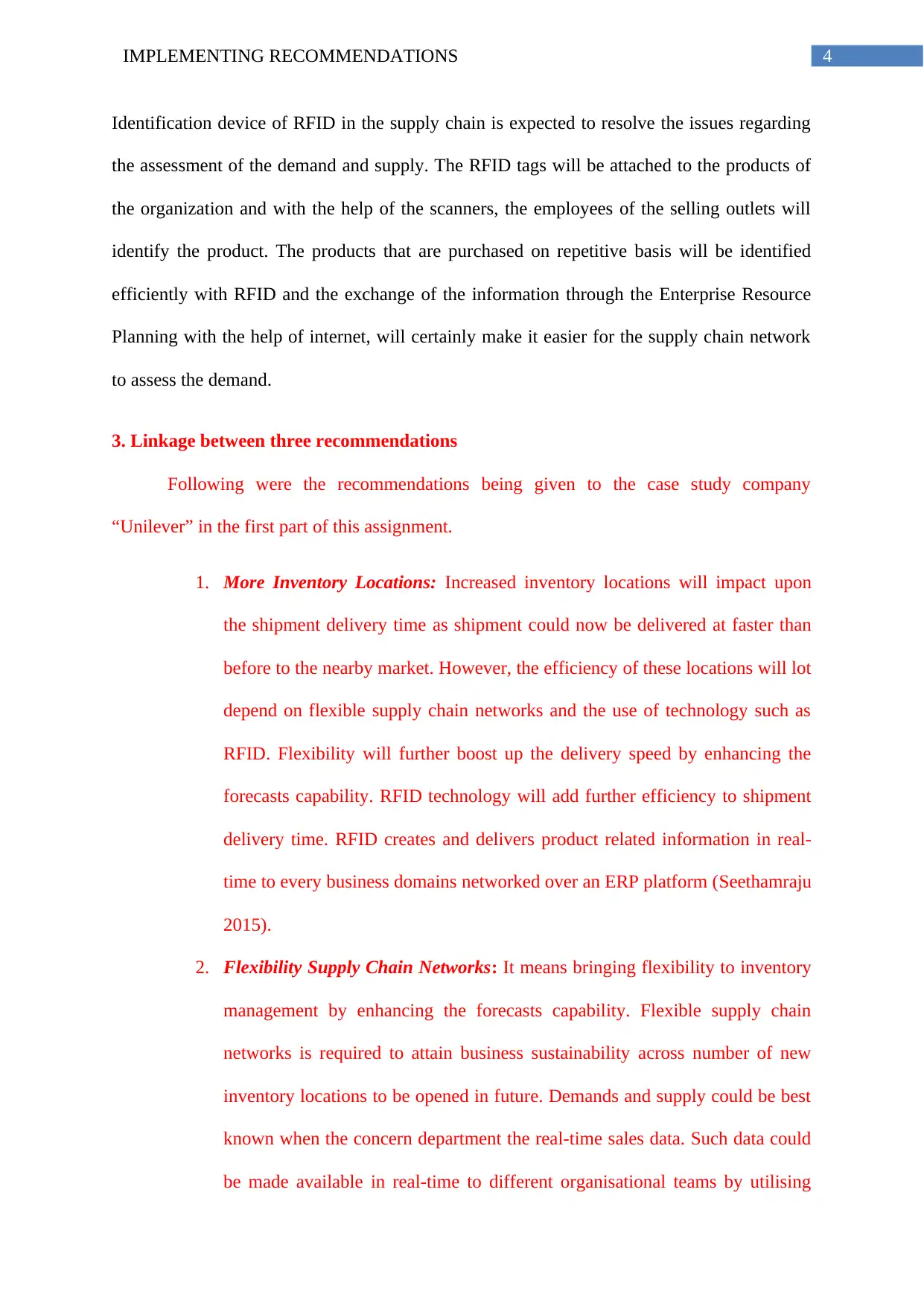
4IMPLEMENTING RECOMMENDATIONS
Identification device of RFID in the supply chain is expected to resolve the issues regarding
the assessment of the demand and supply. The RFID tags will be attached to the products of
the organization and with the help of the scanners, the employees of the selling outlets will
identify the product. The products that are purchased on repetitive basis will be identified
efficiently with RFID and the exchange of the information through the Enterprise Resource
Planning with the help of internet, will certainly make it easier for the supply chain network
to assess the demand.
3. Linkage between three recommendations
Following were the recommendations being given to the case study company
“Unilever” in the first part of this assignment.
1. More Inventory Locations: Increased inventory locations will impact upon
the shipment delivery time as shipment could now be delivered at faster than
before to the nearby market. However, the efficiency of these locations will lot
depend on flexible supply chain networks and the use of technology such as
RFID. Flexibility will further boost up the delivery speed by enhancing the
forecasts capability. RFID technology will add further efficiency to shipment
delivery time. RFID creates and delivers product related information in real-
time to every business domains networked over an ERP platform (Seethamraju
2015).
2. Flexibility Supply Chain Networks: It means bringing flexibility to inventory
management by enhancing the forecasts capability. Flexible supply chain
networks is required to attain business sustainability across number of new
inventory locations to be opened in future. Demands and supply could be best
known when the concern department the real-time sales data. Such data could
be made available in real-time to different organisational teams by utilising
Identification device of RFID in the supply chain is expected to resolve the issues regarding
the assessment of the demand and supply. The RFID tags will be attached to the products of
the organization and with the help of the scanners, the employees of the selling outlets will
identify the product. The products that are purchased on repetitive basis will be identified
efficiently with RFID and the exchange of the information through the Enterprise Resource
Planning with the help of internet, will certainly make it easier for the supply chain network
to assess the demand.
3. Linkage between three recommendations
Following were the recommendations being given to the case study company
“Unilever” in the first part of this assignment.
1. More Inventory Locations: Increased inventory locations will impact upon
the shipment delivery time as shipment could now be delivered at faster than
before to the nearby market. However, the efficiency of these locations will lot
depend on flexible supply chain networks and the use of technology such as
RFID. Flexibility will further boost up the delivery speed by enhancing the
forecasts capability. RFID technology will add further efficiency to shipment
delivery time. RFID creates and delivers product related information in real-
time to every business domains networked over an ERP platform (Seethamraju
2015).
2. Flexibility Supply Chain Networks: It means bringing flexibility to inventory
management by enhancing the forecasts capability. Flexible supply chain
networks is required to attain business sustainability across number of new
inventory locations to be opened in future. Demands and supply could be best
known when the concern department the real-time sales data. Such data could
be made available in real-time to different organisational teams by utilising
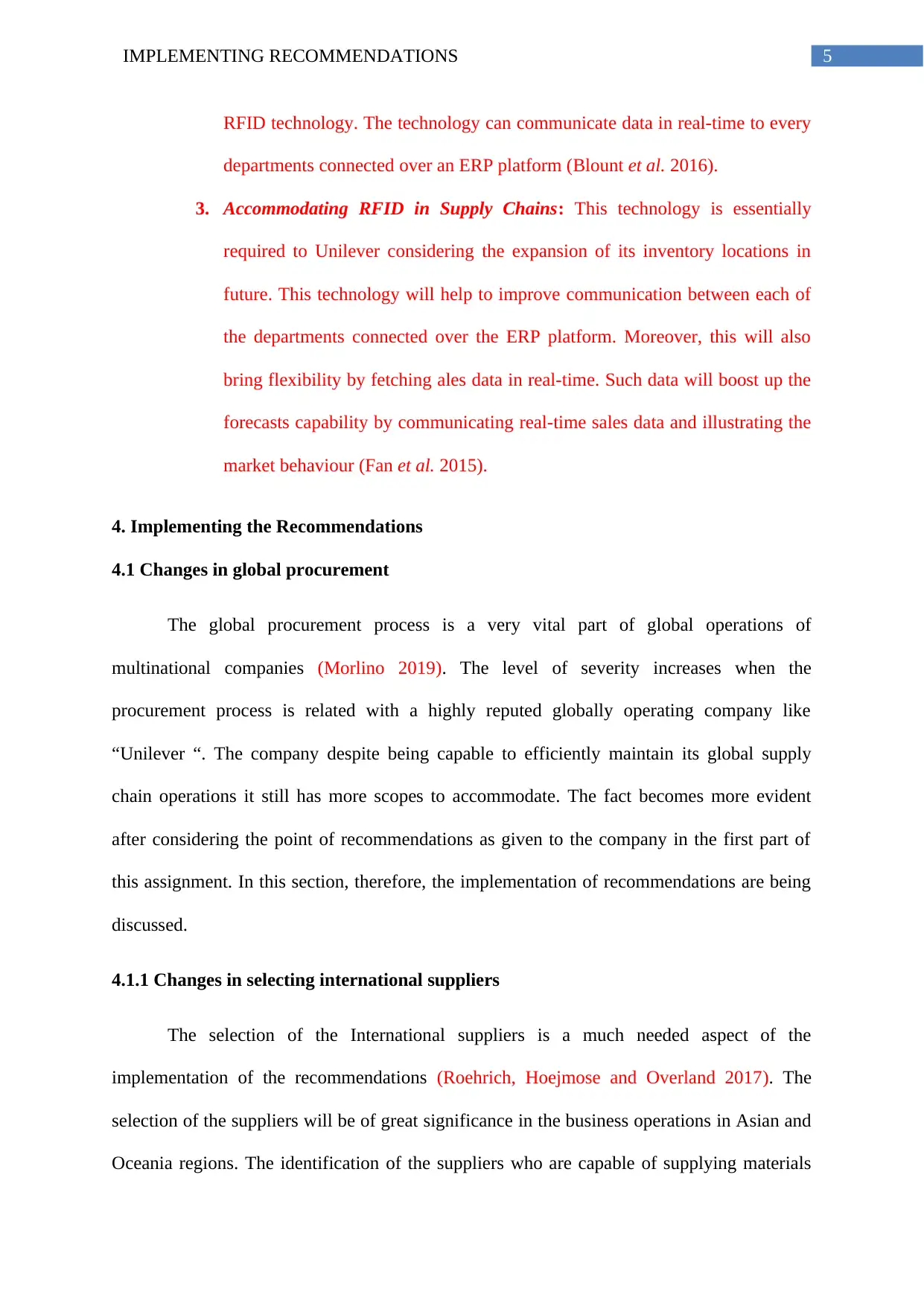
5IMPLEMENTING RECOMMENDATIONS
RFID technology. The technology can communicate data in real-time to every
departments connected over an ERP platform (Blount et al. 2016).
3. Accommodating RFID in Supply Chains: This technology is essentially
required to Unilever considering the expansion of its inventory locations in
future. This technology will help to improve communication between each of
the departments connected over the ERP platform. Moreover, this will also
bring flexibility by fetching ales data in real-time. Such data will boost up the
forecasts capability by communicating real-time sales data and illustrating the
market behaviour (Fan et al. 2015).
4. Implementing the Recommendations
4.1 Changes in global procurement
The global procurement process is a very vital part of global operations of
multinational companies (Morlino 2019). The level of severity increases when the
procurement process is related with a highly reputed globally operating company like
“Unilever “. The company despite being capable to efficiently maintain its global supply
chain operations it still has more scopes to accommodate. The fact becomes more evident
after considering the point of recommendations as given to the company in the first part of
this assignment. In this section, therefore, the implementation of recommendations are being
discussed.
4.1.1 Changes in selecting international suppliers
The selection of the International suppliers is a much needed aspect of the
implementation of the recommendations (Roehrich, Hoejmose and Overland 2017). The
selection of the suppliers will be of great significance in the business operations in Asian and
Oceania regions. The identification of the suppliers who are capable of supplying materials
RFID technology. The technology can communicate data in real-time to every
departments connected over an ERP platform (Blount et al. 2016).
3. Accommodating RFID in Supply Chains: This technology is essentially
required to Unilever considering the expansion of its inventory locations in
future. This technology will help to improve communication between each of
the departments connected over the ERP platform. Moreover, this will also
bring flexibility by fetching ales data in real-time. Such data will boost up the
forecasts capability by communicating real-time sales data and illustrating the
market behaviour (Fan et al. 2015).
4. Implementing the Recommendations
4.1 Changes in global procurement
The global procurement process is a very vital part of global operations of
multinational companies (Morlino 2019). The level of severity increases when the
procurement process is related with a highly reputed globally operating company like
“Unilever “. The company despite being capable to efficiently maintain its global supply
chain operations it still has more scopes to accommodate. The fact becomes more evident
after considering the point of recommendations as given to the company in the first part of
this assignment. In this section, therefore, the implementation of recommendations are being
discussed.
4.1.1 Changes in selecting international suppliers
The selection of the International suppliers is a much needed aspect of the
implementation of the recommendations (Roehrich, Hoejmose and Overland 2017). The
selection of the suppliers will be of great significance in the business operations in Asian and
Oceania regions. The identification of the suppliers who are capable of supplying materials
⊘ This is a preview!⊘
Do you want full access?
Subscribe today to unlock all pages.

Trusted by 1+ million students worldwide

6IMPLEMENTING RECOMMENDATIONS
with affordable pricing and within the deadlines, will increase the effectiveness of the
business operations in the new locations.
One of the very important aspects of selecting the suppliers is to work only with
strategic suppliers than working with a huge number of suppliers lacking strategic capabilities
(De Boer, Labro and Morlacchi 2001). The article emphasises on to find strategic suppliers.
Indeed, this is very challenging to identify and reach to strategic suppliers. According to De
Boer, Labro and Morlacchi (2001), a large attention is paid to the choice phase, which is a
part of the supplier selection process. Employers eventually misses in paying attention to its
prior stages like problem definition, criteria formulation and qualification. Indeed, the quality
of the choice phase is much more dependent on these prior phases of the supplier selection
phase. Hence, there is a need to redesign the approach to be taken to reach to potential and
strategic international suppliers.
The first step to reach to such suppliers would be to search a number of suppliers from
the country that Unilever intends to work with. Once the database of suppliers is created this
can be analysed in respect to a variety of eligibility criteria for strategic suppliers to shortlist
only the quality suppliers. Some of the piece of eligibility criteria to look for are (Mangan,
Lalwani and Lalwani 2016):
The supplier should possess a desire to learn about the priorities and factors, which
have their influence on the business as earlier suppliers possessed only the knowledge
on what their clients expect them to deliver. They had limited or no idea on how
things impact the business in the client firms (Chowdhury, Sundström and Hyder
2016).
The supplier must be possessing a thirst to create a seamless relationship with the
employer. Suppliers do indeed know that Unilever is their huge client and they won’t
with affordable pricing and within the deadlines, will increase the effectiveness of the
business operations in the new locations.
One of the very important aspects of selecting the suppliers is to work only with
strategic suppliers than working with a huge number of suppliers lacking strategic capabilities
(De Boer, Labro and Morlacchi 2001). The article emphasises on to find strategic suppliers.
Indeed, this is very challenging to identify and reach to strategic suppliers. According to De
Boer, Labro and Morlacchi (2001), a large attention is paid to the choice phase, which is a
part of the supplier selection process. Employers eventually misses in paying attention to its
prior stages like problem definition, criteria formulation and qualification. Indeed, the quality
of the choice phase is much more dependent on these prior phases of the supplier selection
phase. Hence, there is a need to redesign the approach to be taken to reach to potential and
strategic international suppliers.
The first step to reach to such suppliers would be to search a number of suppliers from
the country that Unilever intends to work with. Once the database of suppliers is created this
can be analysed in respect to a variety of eligibility criteria for strategic suppliers to shortlist
only the quality suppliers. Some of the piece of eligibility criteria to look for are (Mangan,
Lalwani and Lalwani 2016):
The supplier should possess a desire to learn about the priorities and factors, which
have their influence on the business as earlier suppliers possessed only the knowledge
on what their clients expect them to deliver. They had limited or no idea on how
things impact the business in the client firms (Chowdhury, Sundström and Hyder
2016).
The supplier must be possessing a thirst to create a seamless relationship with the
employer. Suppliers do indeed know that Unilever is their huge client and they won’t
Paraphrase This Document
Need a fresh take? Get an instant paraphrase of this document with our AI Paraphraser
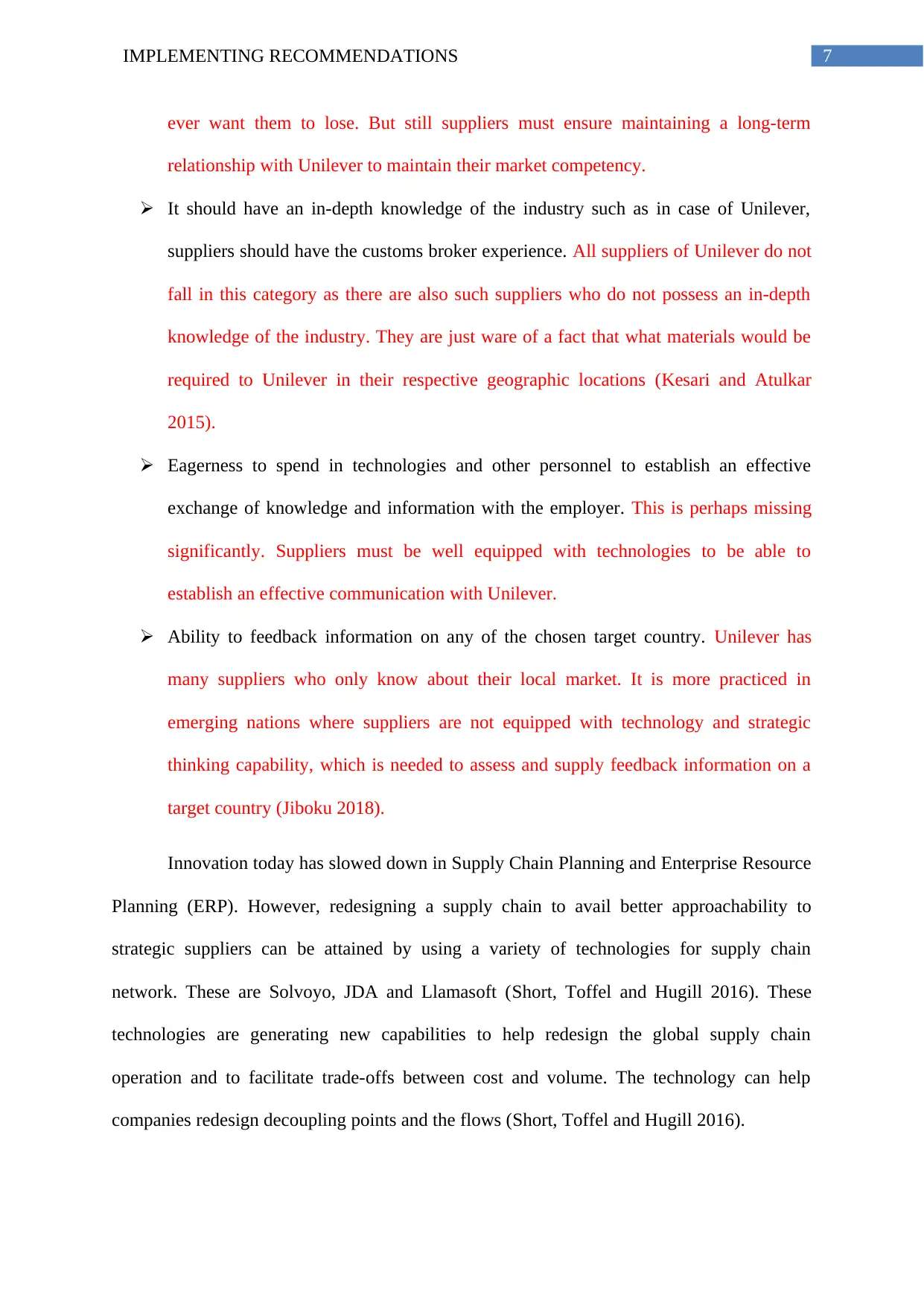
7IMPLEMENTING RECOMMENDATIONS
ever want them to lose. But still suppliers must ensure maintaining a long-term
relationship with Unilever to maintain their market competency.
It should have an in-depth knowledge of the industry such as in case of Unilever,
suppliers should have the customs broker experience. All suppliers of Unilever do not
fall in this category as there are also such suppliers who do not possess an in-depth
knowledge of the industry. They are just ware of a fact that what materials would be
required to Unilever in their respective geographic locations (Kesari and Atulkar
2015).
Eagerness to spend in technologies and other personnel to establish an effective
exchange of knowledge and information with the employer. This is perhaps missing
significantly. Suppliers must be well equipped with technologies to be able to
establish an effective communication with Unilever.
Ability to feedback information on any of the chosen target country. Unilever has
many suppliers who only know about their local market. It is more practiced in
emerging nations where suppliers are not equipped with technology and strategic
thinking capability, which is needed to assess and supply feedback information on a
target country (Jiboku 2018).
Innovation today has slowed down in Supply Chain Planning and Enterprise Resource
Planning (ERP). However, redesigning a supply chain to avail better approachability to
strategic suppliers can be attained by using a variety of technologies for supply chain
network. These are Solvoyo, JDA and Llamasoft (Short, Toffel and Hugill 2016). These
technologies are generating new capabilities to help redesign the global supply chain
operation and to facilitate trade-offs between cost and volume. The technology can help
companies redesign decoupling points and the flows (Short, Toffel and Hugill 2016).
ever want them to lose. But still suppliers must ensure maintaining a long-term
relationship with Unilever to maintain their market competency.
It should have an in-depth knowledge of the industry such as in case of Unilever,
suppliers should have the customs broker experience. All suppliers of Unilever do not
fall in this category as there are also such suppliers who do not possess an in-depth
knowledge of the industry. They are just ware of a fact that what materials would be
required to Unilever in their respective geographic locations (Kesari and Atulkar
2015).
Eagerness to spend in technologies and other personnel to establish an effective
exchange of knowledge and information with the employer. This is perhaps missing
significantly. Suppliers must be well equipped with technologies to be able to
establish an effective communication with Unilever.
Ability to feedback information on any of the chosen target country. Unilever has
many suppliers who only know about their local market. It is more practiced in
emerging nations where suppliers are not equipped with technology and strategic
thinking capability, which is needed to assess and supply feedback information on a
target country (Jiboku 2018).
Innovation today has slowed down in Supply Chain Planning and Enterprise Resource
Planning (ERP). However, redesigning a supply chain to avail better approachability to
strategic suppliers can be attained by using a variety of technologies for supply chain
network. These are Solvoyo, JDA and Llamasoft (Short, Toffel and Hugill 2016). These
technologies are generating new capabilities to help redesign the global supply chain
operation and to facilitate trade-offs between cost and volume. The technology can help
companies redesign decoupling points and the flows (Short, Toffel and Hugill 2016).

8IMPLEMENTING RECOMMENDATIONS
Figure 1: Different Customer Order Decoupling Points
(Source: Olhager 2012)
An implementation phase in respect to selecting international suppliers would also
include a few more points. One of these points is establishing an effective communication
between the work teams. The implementation may take a long. It is, therefore, important to
be in regular and continuous communication with the suppliers. In addition, Unilever should
also understand the model, which will serve its objectives for its global supply chain
operation. They can chose from a several models such as model for labour, transportation and
duties. There is also the need to define both effectiveness and efficiency (Rajeev et al. 2017).
4.1.2 Changes in buying from international suppliers
The purchases of the products from the International suppliers will be effective for the
organizations as the purchases from the suppliers belonging to mid-market will provide an
advantage to the organization in applying a competitive pricing strategy in the upscale
market. However, this section seeks ways to implement one of the recommendations as given
to Unilever in the first past of this assignment. It is about setting more inventory locations
across the globe to be able to enhance the supply chain efficiency and reduce the supply chain
operations cost. However, new set ups must be supported with a strategic B2B buying mode
to help Unilever monitor and control the performance of its international suppliers. There are
Figure 1: Different Customer Order Decoupling Points
(Source: Olhager 2012)
An implementation phase in respect to selecting international suppliers would also
include a few more points. One of these points is establishing an effective communication
between the work teams. The implementation may take a long. It is, therefore, important to
be in regular and continuous communication with the suppliers. In addition, Unilever should
also understand the model, which will serve its objectives for its global supply chain
operation. They can chose from a several models such as model for labour, transportation and
duties. There is also the need to define both effectiveness and efficiency (Rajeev et al. 2017).
4.1.2 Changes in buying from international suppliers
The purchases of the products from the International suppliers will be effective for the
organizations as the purchases from the suppliers belonging to mid-market will provide an
advantage to the organization in applying a competitive pricing strategy in the upscale
market. However, this section seeks ways to implement one of the recommendations as given
to Unilever in the first past of this assignment. It is about setting more inventory locations
across the globe to be able to enhance the supply chain efficiency and reduce the supply chain
operations cost. However, new set ups must be supported with a strategic B2B buying mode
to help Unilever monitor and control the performance of its international suppliers. There are
⊘ This is a preview!⊘
Do you want full access?
Subscribe today to unlock all pages.

Trusted by 1+ million students worldwide
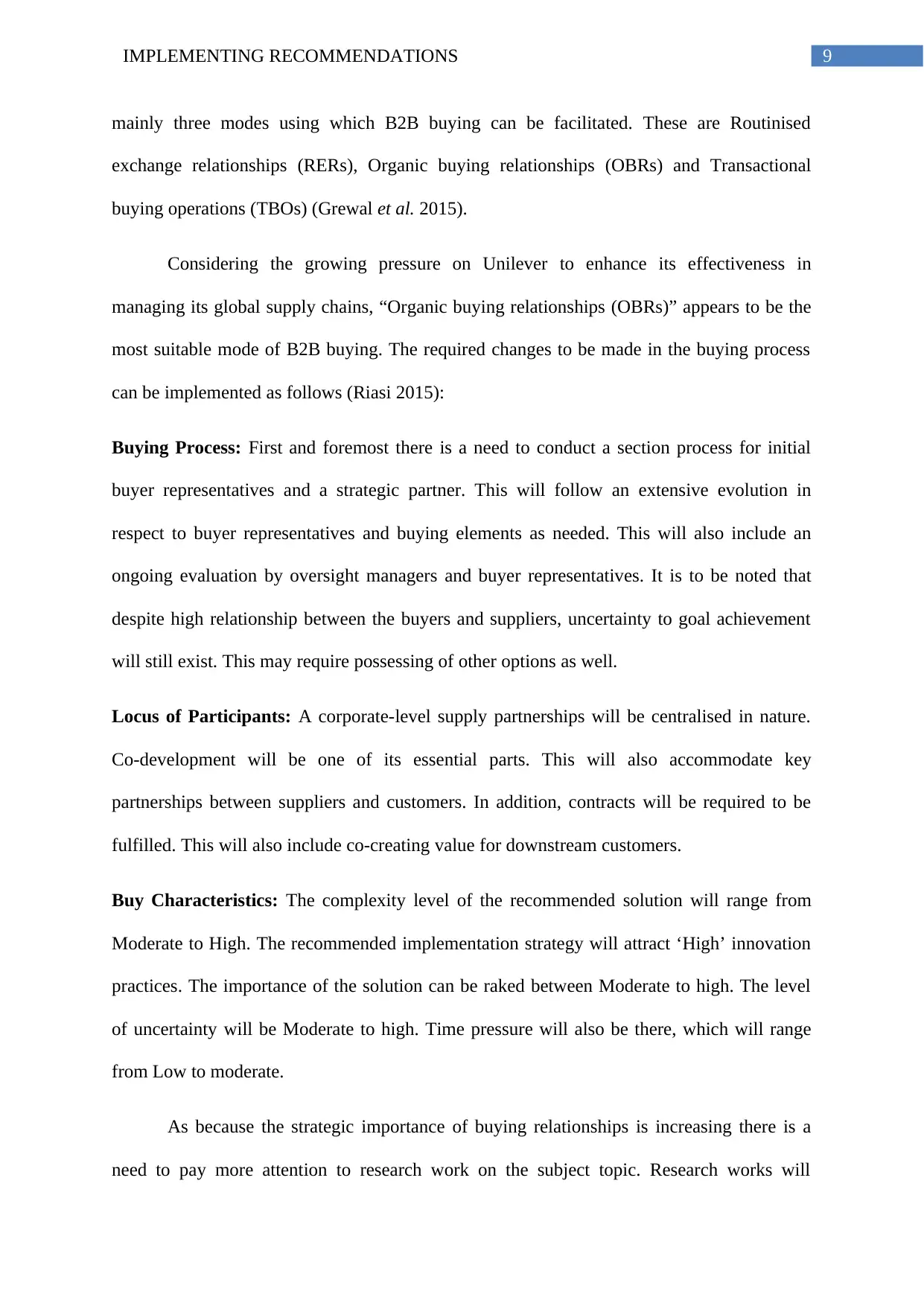
9IMPLEMENTING RECOMMENDATIONS
mainly three modes using which B2B buying can be facilitated. These are Routinised
exchange relationships (RERs), Organic buying relationships (OBRs) and Transactional
buying operations (TBOs) (Grewal et al. 2015).
Considering the growing pressure on Unilever to enhance its effectiveness in
managing its global supply chains, “Organic buying relationships (OBRs)” appears to be the
most suitable mode of B2B buying. The required changes to be made in the buying process
can be implemented as follows (Riasi 2015):
Buying Process: First and foremost there is a need to conduct a section process for initial
buyer representatives and a strategic partner. This will follow an extensive evolution in
respect to buyer representatives and buying elements as needed. This will also include an
ongoing evaluation by oversight managers and buyer representatives. It is to be noted that
despite high relationship between the buyers and suppliers, uncertainty to goal achievement
will still exist. This may require possessing of other options as well.
Locus of Participants: A corporate-level supply partnerships will be centralised in nature.
Co-development will be one of its essential parts. This will also accommodate key
partnerships between suppliers and customers. In addition, contracts will be required to be
fulfilled. This will also include co-creating value for downstream customers.
Buy Characteristics: The complexity level of the recommended solution will range from
Moderate to High. The recommended implementation strategy will attract ‘High’ innovation
practices. The importance of the solution can be raked between Moderate to high. The level
of uncertainty will be Moderate to high. Time pressure will also be there, which will range
from Low to moderate.
As because the strategic importance of buying relationships is increasing there is a
need to pay more attention to research work on the subject topic. Research works will
mainly three modes using which B2B buying can be facilitated. These are Routinised
exchange relationships (RERs), Organic buying relationships (OBRs) and Transactional
buying operations (TBOs) (Grewal et al. 2015).
Considering the growing pressure on Unilever to enhance its effectiveness in
managing its global supply chains, “Organic buying relationships (OBRs)” appears to be the
most suitable mode of B2B buying. The required changes to be made in the buying process
can be implemented as follows (Riasi 2015):
Buying Process: First and foremost there is a need to conduct a section process for initial
buyer representatives and a strategic partner. This will follow an extensive evolution in
respect to buyer representatives and buying elements as needed. This will also include an
ongoing evaluation by oversight managers and buyer representatives. It is to be noted that
despite high relationship between the buyers and suppliers, uncertainty to goal achievement
will still exist. This may require possessing of other options as well.
Locus of Participants: A corporate-level supply partnerships will be centralised in nature.
Co-development will be one of its essential parts. This will also accommodate key
partnerships between suppliers and customers. In addition, contracts will be required to be
fulfilled. This will also include co-creating value for downstream customers.
Buy Characteristics: The complexity level of the recommended solution will range from
Moderate to High. The recommended implementation strategy will attract ‘High’ innovation
practices. The importance of the solution can be raked between Moderate to high. The level
of uncertainty will be Moderate to high. Time pressure will also be there, which will range
from Low to moderate.
As because the strategic importance of buying relationships is increasing there is a
need to pay more attention to research work on the subject topic. Research works will
Paraphrase This Document
Need a fresh take? Get an instant paraphrase of this document with our AI Paraphraser

10IMPLEMENTING RECOMMENDATIONS
produce more informed practices in the concerned area. It is to be noted that B2B buying is
becoming a growing concern for the worldwide business leaders across the globe. Hence,
there is a need for creative research works and the theory developments.
4.1.3 Changes in managing international suppliers
In a highly volatile world economy and the politics it is essential for multinational
firms to act strategically towards a range of its operations objectives. Companies such as
Unilever that are constantly growing should follow a robust model for managing international
suppliers. Unilever should increase the number of its inventory stores across the globe to be
able to deliver products to market in a reduced time span. This has also been recommended in
the first part of this assignment. However, increasing the number of inventory stores will not
alone boost the efficiency in sending products to market. This will also require an effective
and involved contribution from international suppliers. An effective management of
international suppliers can be attained by following a model for vendor management. In this
regard, the Japanese Model can be really helpful.
The Japanese Model has effectively helped a number of Japanese companies in
achieving a long-term mutual and cooperative dependency between suppliers and a buyer.
This model can help to produce products having minimised defects and reduced total
manufacturing costs. It is to be noted that Japanese companies work with fewer but strategic
suppliers. The model can benefit employers such as Unilever in many ways like those
mentioned as below (Gonzalez-Loureiro, Dabic and Kiessling 2015):
Long-term relationship with suppliers: The model encourages to work with fewer but
strategic suppliers. It is due to many reasons. Working with fewer suppliers will be handful in
reducing the variability in regards to quality and price. Japanese companies rarely have
working relationship with more than two or three suppliers for a product. It helps them
produce more informed practices in the concerned area. It is to be noted that B2B buying is
becoming a growing concern for the worldwide business leaders across the globe. Hence,
there is a need for creative research works and the theory developments.
4.1.3 Changes in managing international suppliers
In a highly volatile world economy and the politics it is essential for multinational
firms to act strategically towards a range of its operations objectives. Companies such as
Unilever that are constantly growing should follow a robust model for managing international
suppliers. Unilever should increase the number of its inventory stores across the globe to be
able to deliver products to market in a reduced time span. This has also been recommended in
the first part of this assignment. However, increasing the number of inventory stores will not
alone boost the efficiency in sending products to market. This will also require an effective
and involved contribution from international suppliers. An effective management of
international suppliers can be attained by following a model for vendor management. In this
regard, the Japanese Model can be really helpful.
The Japanese Model has effectively helped a number of Japanese companies in
achieving a long-term mutual and cooperative dependency between suppliers and a buyer.
This model can help to produce products having minimised defects and reduced total
manufacturing costs. It is to be noted that Japanese companies work with fewer but strategic
suppliers. The model can benefit employers such as Unilever in many ways like those
mentioned as below (Gonzalez-Loureiro, Dabic and Kiessling 2015):
Long-term relationship with suppliers: The model encourages to work with fewer but
strategic suppliers. It is due to many reasons. Working with fewer suppliers will be handful in
reducing the variability in regards to quality and price. Japanese companies rarely have
working relationship with more than two or three suppliers for a product. It helps them
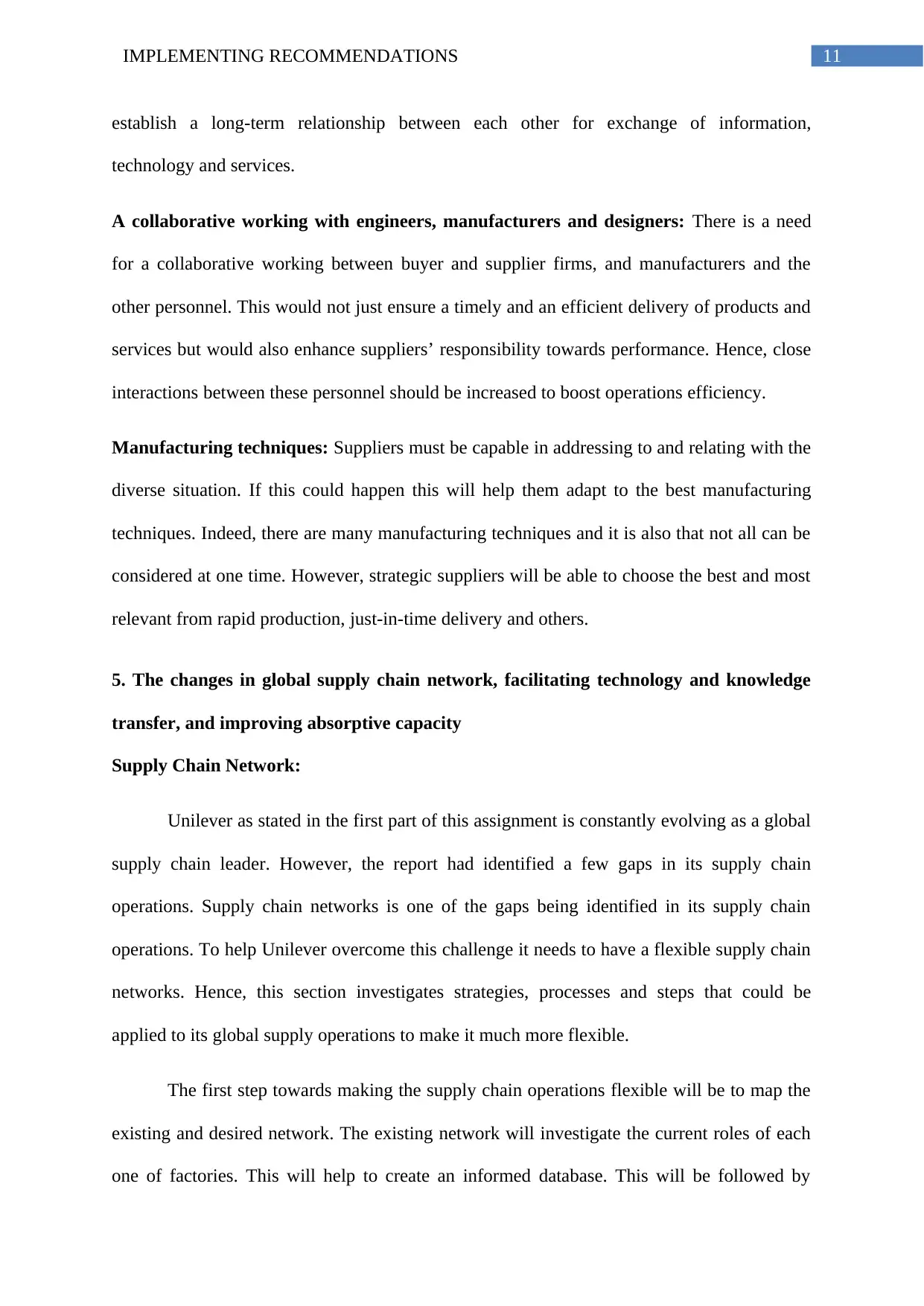
11IMPLEMENTING RECOMMENDATIONS
establish a long-term relationship between each other for exchange of information,
technology and services.
A collaborative working with engineers, manufacturers and designers: There is a need
for a collaborative working between buyer and supplier firms, and manufacturers and the
other personnel. This would not just ensure a timely and an efficient delivery of products and
services but would also enhance suppliers’ responsibility towards performance. Hence, close
interactions between these personnel should be increased to boost operations efficiency.
Manufacturing techniques: Suppliers must be capable in addressing to and relating with the
diverse situation. If this could happen this will help them adapt to the best manufacturing
techniques. Indeed, there are many manufacturing techniques and it is also that not all can be
considered at one time. However, strategic suppliers will be able to choose the best and most
relevant from rapid production, just-in-time delivery and others.
5. The changes in global supply chain network, facilitating technology and knowledge
transfer, and improving absorptive capacity
Supply Chain Network:
Unilever as stated in the first part of this assignment is constantly evolving as a global
supply chain leader. However, the report had identified a few gaps in its supply chain
operations. Supply chain networks is one of the gaps being identified in its supply chain
operations. To help Unilever overcome this challenge it needs to have a flexible supply chain
networks. Hence, this section investigates strategies, processes and steps that could be
applied to its global supply operations to make it much more flexible.
The first step towards making the supply chain operations flexible will be to map the
existing and desired network. The existing network will investigate the current roles of each
one of factories. This will help to create an informed database. This will be followed by
establish a long-term relationship between each other for exchange of information,
technology and services.
A collaborative working with engineers, manufacturers and designers: There is a need
for a collaborative working between buyer and supplier firms, and manufacturers and the
other personnel. This would not just ensure a timely and an efficient delivery of products and
services but would also enhance suppliers’ responsibility towards performance. Hence, close
interactions between these personnel should be increased to boost operations efficiency.
Manufacturing techniques: Suppliers must be capable in addressing to and relating with the
diverse situation. If this could happen this will help them adapt to the best manufacturing
techniques. Indeed, there are many manufacturing techniques and it is also that not all can be
considered at one time. However, strategic suppliers will be able to choose the best and most
relevant from rapid production, just-in-time delivery and others.
5. The changes in global supply chain network, facilitating technology and knowledge
transfer, and improving absorptive capacity
Supply Chain Network:
Unilever as stated in the first part of this assignment is constantly evolving as a global
supply chain leader. However, the report had identified a few gaps in its supply chain
operations. Supply chain networks is one of the gaps being identified in its supply chain
operations. To help Unilever overcome this challenge it needs to have a flexible supply chain
networks. Hence, this section investigates strategies, processes and steps that could be
applied to its global supply operations to make it much more flexible.
The first step towards making the supply chain operations flexible will be to map the
existing and desired network. The existing network will investigate the current roles of each
one of factories. This will help to create an informed database. This will be followed by
⊘ This is a preview!⊘
Do you want full access?
Subscribe today to unlock all pages.

Trusted by 1+ million students worldwide
1 out of 19
Related Documents
Your All-in-One AI-Powered Toolkit for Academic Success.
+13062052269
info@desklib.com
Available 24*7 on WhatsApp / Email
![[object Object]](/_next/static/media/star-bottom.7253800d.svg)
Unlock your academic potential
Copyright © 2020–2025 A2Z Services. All Rights Reserved. Developed and managed by ZUCOL.





